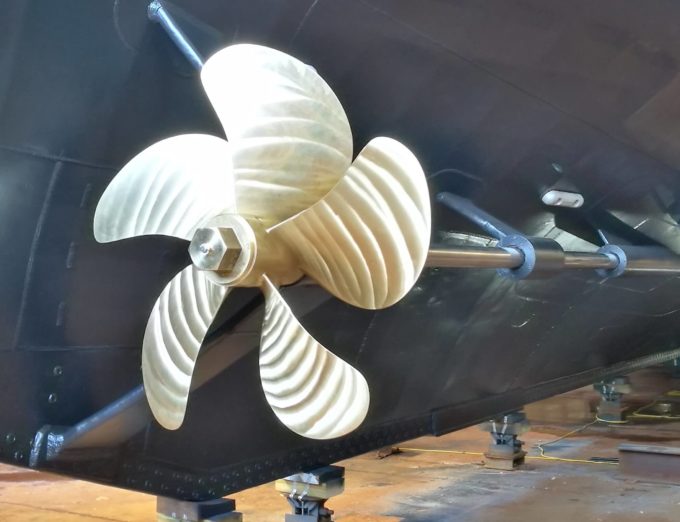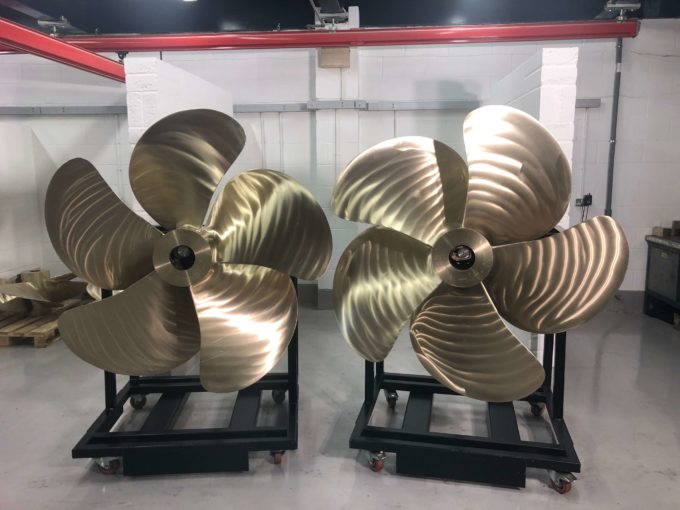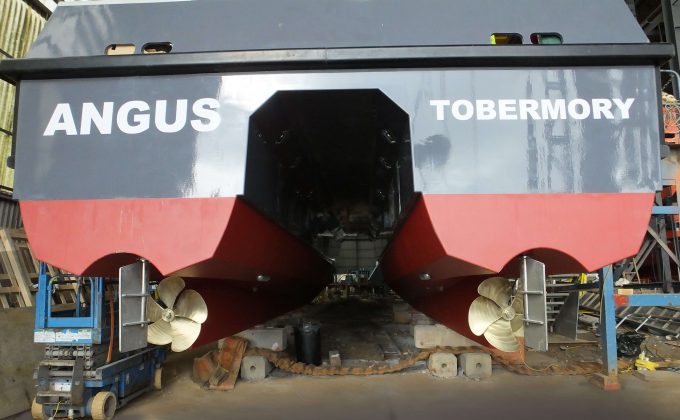Not all propellers are made equal.
Propeller packages from CJR consistently outperform the competition and are proven to increase top speed, consume less fuel, last longer, and reduce noise, vibration and cavitation.
Every CJR propeller is designed to the highest quality standards and is custom-made for the specific vessel in question using advanced design and production technology to do so. Our continuous investment in precision manufacturing technology is combined with a data and intelligence-led mindset, to deliver the ultimate in propulsion performance and efficiency as standard. Equally, every CJR propeller can be manufactured to any classification society rules, including all IACS societies for complete peace of mind.
For more information, visit our complete guide to propellers.
Our unique end-to-end design and manufacturing process is unrivalled in Europe and leverages the latest in CFD and FEA design software, highly accurate pattern-less moulding, and five-axis CNC-machining to create truly bespoke propulsion solutions that deliver long-term benefits and efficiencies. This means every CJR propeller is designed without constraint, to the precise requirements of the vessel and its intended application.
If required we can analyse the entire propulsion system of each boat starting from hull resistance prediction and hull propulsive factors. We select the most efficient gear ratio, recommend changes if needed and analyse flow in every point under the hull using the most advanced CFD tools developed specifically for our requirements.
For all propellers made outside of a production run, we will miss out the pattern-making process and use this method for casting propellers instead. We machine blocks of sand and resin to make a mould for casting propellers. This is a very quick process which allows us to make propellers in two weeks when required.
We use patterns if we are making a series of propellers. For isolated, bespoke orders we wil use the sand moulds instead (see above). Precise patterns ensure high accuracy of final product and are one of the most important stages in the manufacturing process of casting items of complex geometry like propellers, rudders and P-Brackets.
Casting is the stage at which the moulds are filled with molten metal. CJR’s foundry team has the combined benefits of over 150 years experience in the industry. This experience coupled with our excellent software, tooling and patterns provides an extremely efficient and highly productive output of quality castings.
CAD/CAM controlled machining of the cast propellers, P brackets and rudders are undertaken to the fine tolerances of their original design, which ensures that the finished components perform as predicted.
Our processes ensure that the geometry of our finished castings is always true and accurate to the original design. Consequently, there’s little need for extensive finishing, which can offer significant cost and time savings. Additionally, our digital inspection equipment thoroughly checks every component for everything from geometry to skew, rake and pitch.
CJR is committed to achieving a best in class standard of quality with all products and processes. The final product that is supplied to our customers has passed a full process of quality procedures involving material traceability and analysis and dimensional evaluation at each phase of manufacture. All propellers are inspected to ISO 484 Class S standards to ensure optimum performance, smoothness and efficiency
Propeller packages from CJR consistently outperform the competition and are proven to increase top speed, consume less fuel, last longer, and reduce noise, vibration and cavitation.
Customers have reported saving as much as 10% in fuel costs per annum and have increased top speed by up to two knots simply by switching from a set of hand-finished propellers to a set of fully bespoke CJR fully CNC machined propellers.
The propeller is one of the most sensitive parts of the boat and is impacted by the vessel’s displacement, trim, appendages, hull fouling and engine performance, as well as trial conditions like sea state or wind. Whether your propellers are intended for a superyacht, motor yacht or commercial vessel, you need a propulsion partner that takes the time to understand every relevant factor; how your vessel is being used, its loading and any individual propulsion requirements or challenges.
We gather this critical vessel data and use our technology-driven approach, commitment to customer service and manufacturing excellence to provide our customers with the confidence they need – safe in the knowledge that their propeller package will meet their requirements in terms of performance, efficiency, longevity and ride comfort.
CJR has recently launched a rapid turnaround service offering bespoke, fully optimised Class-S propellers in just 14 days or less. Designed for propellers up to 1500mm in diameter, our replacement propeller services can save as much as three months from the typical replacement timeline. For more information, visit our dedicated Rapid Turnaround page.
Our Nautica propeller range is designed for vessels looking for exceptional performance at lower speeds, making it ideally suited for fishing boats, trawlers, sailing yachts, displacement motor yachts or survey vessels.
Our MRK Revolution propeller range is our most popular custom-made solution, designed for vessels looking for minimal noise and vibration at a medium speed range of 20-30 knots). It is particularly popular with large luxury yachts, semi-displacement and planing production motorboat builders.
Our Billfish propeller range is designed specifically for high speed Sportfish boats and has proven to outperform competitors at speeds of up to 45kts. The design and manufacture of the Billfish propeller takes into account the specific operating requirements of the Sportfish market, including maximum speed but also the ability for operators to ‘backdown’ on fish. We have even had reports that the CJR Billfish acts to ‘bring up the fish’.
The MRK Superprop range has been developed specifically for high speed vessels (sport boats of 32 knots plus, production yachts and patrol craft) and provides the ultimate in performance at sea. After the propellers are tailored to the particular vessel’s specification, the unique profiles are then optimised to deliver maximum speed, responsiveness and efficiency.
The MRK Pilot is designed specifically for workboats, in particular, pilot boats. These propellers are designed to withstand the rugged environment that workboats encounter. The propeller profiles are optimised for efficiency and speed while ensuring cavitation erosion is controlled.



Propellers are sometimes colloquially referred to as ‘screws’, and that’s because at a basic level, they are the same thing. Like a screw is pushed into a wall by a helical thread turning clockwise, a propeller has radiating blades coming away from a central rotating base which are pitched at an angle which dictates how quickly it moves when you turn it. A basic law of physics proposed by Isaac Newton is the idea that if you want to move forward, you have to push backwards. Propellers work because of this principle. A propeller’s turning motion produces a difference in pressure between the front and back surfaces of its blades, also known as thrust. This drives the propeller through the water in the case of marine propellers.
There are many factors to consider when creating the perfect propeller for a particular vessel. The metrics typically used to assess the functionality and quality of a propeller are: the top possible speed; efficiency in fuel consumption; how long it lasts before needing to be replaced; noise emissions; amount of vibration; and the likelihood of cavitation. Every CJR propeller is designed to the highest quality standards and custom-made for the specific vessel in question using advanced design and production technology to do so. CJR’s 80 years of experience mean our propeller manufacturing process is fully optimised to extract the best possible outcomes from these quality metrics.
Cavitation occurs when at low-pressure, vapour bubbles form in a liquid. It causes major erosion to marine propellers underwater and subsequently, a reduction in efficiency, and an increase in noise and vibration. Cavitation can be avoided from the point a propeller is designed by fully analysing and optimising a propeller’s pitch and flow velocity to align perfectly with the vessel.
Arguably the first iteration of the propeller in recorded history is Archimedes’s screw in approximately 200 BC which was essentially a rotating spiral used for water irrigation. The first time the propeller was properly introduced to the marine industry as an alternative way of powering vessels wasn’t until the 1830s when two inventors working in Britain, John Ericson and Francis Pettit Smith demonstrated the effectiveness of steam-propeller fueled vessels and they were subsequently adopted by the British navy and the global commercial marine industry by the mid nineteenth century. One of the early iconic iterations of steam-propellers in action was Brunel’s SS Great Britain.
Innovation in the field of propeller design largely stagnated until the fuel crisis of the 1970s when steam was phased out in favour of the more efficient diesel engine-fuelled propellers.
CJR entered the scene in 1948 and has been a force for innovation in propeller manufacturing ever since. Over the last 5 years, CJR has pioneered the fastest turn-around for bespoke propeller manufacturing in the industry. Its four-million-pound investment in its design and manufacturing facilities include combining CFD with advanced ‘patternless’ robotic mould making, multiple 5-axis CNC machining centres, and the production automation technology required to tie every step of the process together.
For a more detailed history of the propeller from Archimedes to CJR, take a look at our propeller history timeline.
CJR Propulsion is one of the world’s most respected marine propeller manufacturers. Our emergency boat propeller replacement service can provide our clients with an identical copy of their propellers in as little as two weeks*. Our rapid propeller replacement service has been specifically developed to meet the needs of yacht charter businesses, boat owners, and new build and refit boat yards, who need a high quality but timely solution for damaged or broken propellers, or those experiencing propeller performance issues.
Aeroplane propellers have thick and narrow blades that turn at high speed, whereas ship propellers have thinner, broader blades that spin more slowly. Ship propellers also work most efficiently in water at lower speeds because of the difference in density between water and air (about 1000 times more, in fact). Therefore aeroplanes need to move a lot more air then marine propellers need to move water to produce the same amount of momentum.
‘Props’ is a shortened version of ‘propellers’. Other colloquial terms for propellers include a ‘screw’.
CJR has recently launched a rapid turnaround service offering bespoke, fully optimised Class-S propellers in just 14 days or less. Designed for propellers up to 1500mm in diameter, our replacement propeller services can save as much as three months from the typical replacement timeline. For more information, visit our dedicated Rapid Turnaround page.
Replacing a single damaged prop is now significantly easier, quicker and more cost-effective with CJR. Our ability to 3D scan and reverse engineer any propeller to the highest degrees of accuracy is yet another reason to choose CJR. For more information, visit our dedicated 3D scanning page.
CJR combines decades of experience with continuous investment in the latest technology and engineering prowess. Just drop us a note to find out more about how we can help you.
CONTACT US